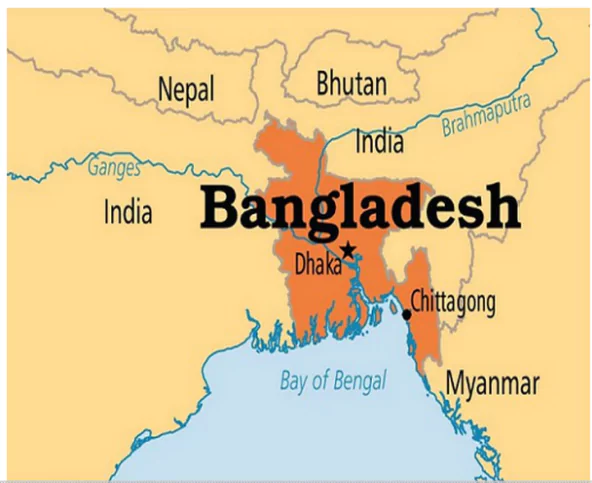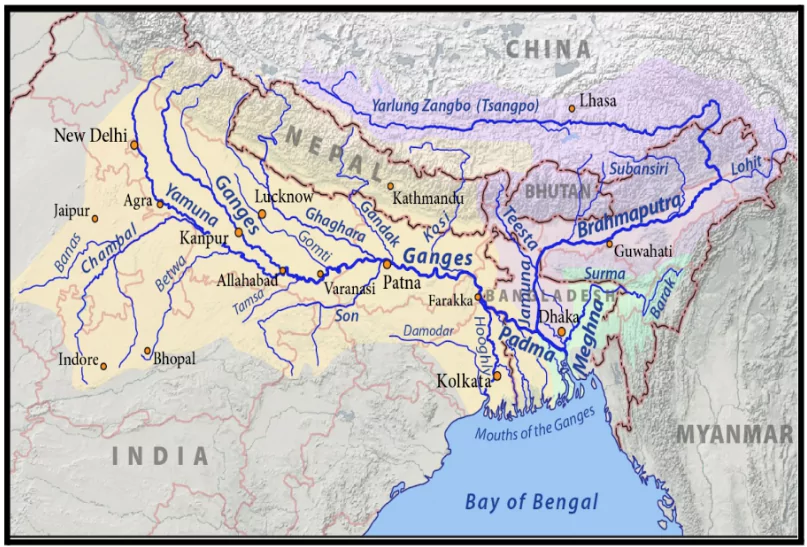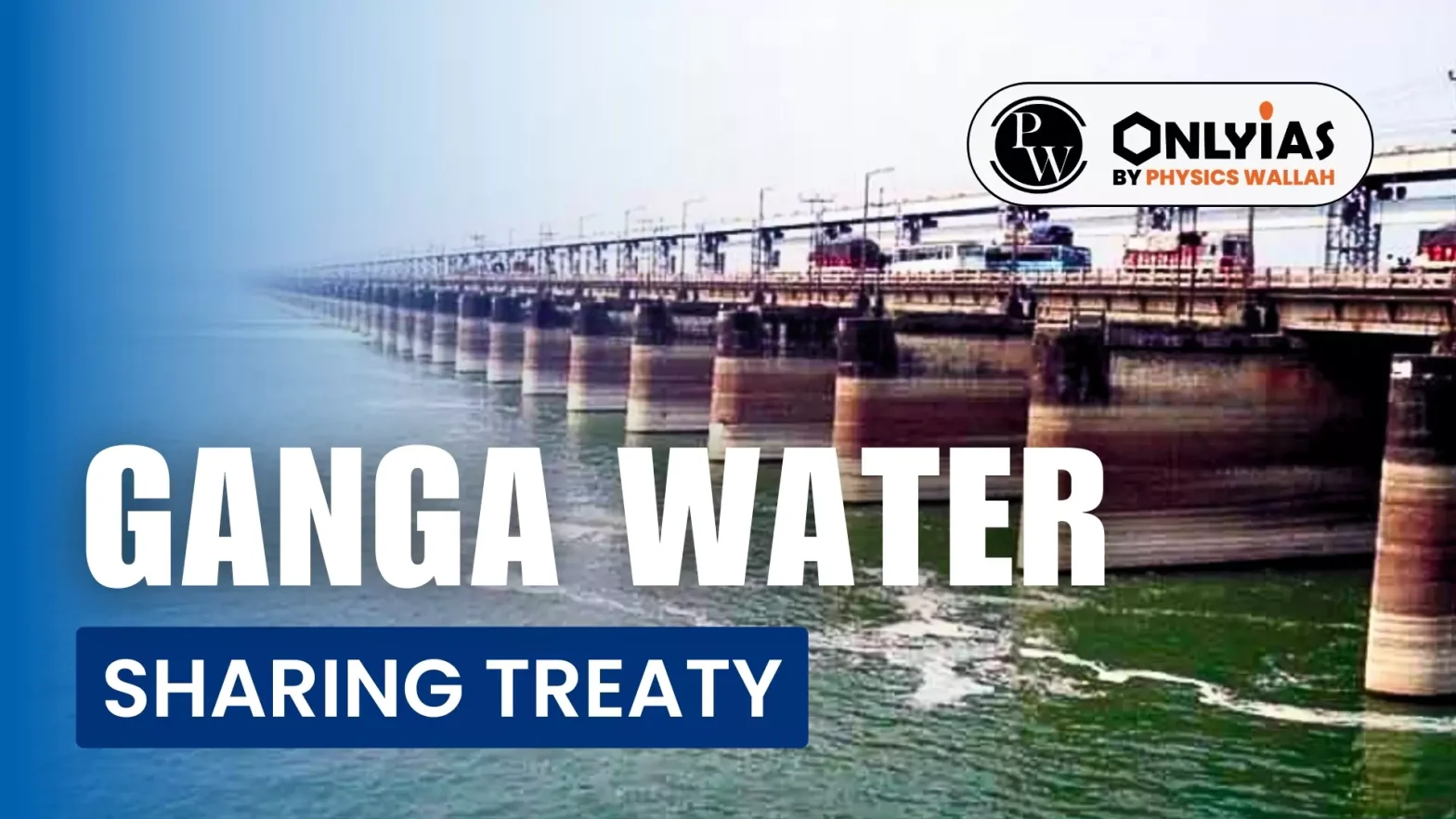The ruling Trinamool Congress criticised the Centre for not consulting the State of West Bengal before taking the decision to start negotiations with Bangladesh for the renewal of the 1996 Ganga Water Sharing Treaty.
Recent Developments

- Renewal of 1996 Ganga Water Treaty: The Indian Prime Minister announced that India and Bangladesh will begin technical-level talks for the renewal of the 1996 Ganga water treaty.
- An Indian technical team will visit Bangladesh soon for the conservation and management of the Teesta river.
- There are criticisms that:
- West Bengal not consulted: However, there are criticisms that West Bengal, a party to the treaty, was not consulted and dues from the previous treaty remain unpaid.
- Dredging of Ganga has been stopped: Additionally, the stoppage of Ganga dredging is claimed to be causing floods and erosion, alleged to be part of a plan to sell off Bengal.
Enroll now for UPSC Online Course
Ganga Water Sharing Treaty
-
Background of the treaty:
- India and Bangladesh share 54 trans-boundary rivers that drain through Bangladesh of which the Ganges is highly seasonal.
- In 1975 India constructed a Barrage across the Ganges at Farakka:
- For diverting the flow of water to the Hooghly River and
- To ensure the flushing of the Calcutta Port thus, affecting Bangladesh ’s share of the Ganges waters.

-
- Under the treaty, the upper riparian India and lower riparian Bangladesh agreed to share the water of this transboundary river at Farakka (which is the last control structure on river Ganga in India), a dam on Bhagirathi river around 10 kms from Bangladesh border
- Validity: The treaty will expire in 2026, when it completes its 30-year term.
- Sharing Period: During lean period, from 1st January to 31st May every year, on a 10-day period basis as per the formula provided in the Treaty.
- Ganga Water Sharing Formula:
- If availability at Farakka is less than 70,000 cusecs: 50:50 split (35,000 cusecs each).
- If availability is between 70,000 and 75,000 cusecs: Bangladesh receives 35,000 cusecs, India gets the rest.
- If availability is 75,000 cusecs or more: India receives 75,000 cusecs, Bangladesh gets the rest.
- Critical Month (April): Bangladesh is guaranteed a flow of 35,000 cusecs in the first and last ten days of April.
- Emergency Adjustments: If flow falls below 50,000 cusecs in any ten-day period, the two governments will consult for emergency adjustments.
- Monitoring: A Joint Committee monitors daily flows at the feeder canal in Farakka and the navigation lock at Hardinge Bridge (the point within Bangladesh where flows are monitored), submitting annual reports to both governments
- Concerns:
- Consultation Concerns: There have been criticisms, particularly from West Bengal, about the lack of consultation in treaty renewals and unmet obligations from previous agreements.
- Floods, Erosion and Siltation: West Bengal and Bihar have raised several concerns about the treaty including erosion, siltation and floods due to the Farakka barrage across river Ganga as it does not allow river sediments to flow with minimal obstruction.
- Increasing Salinity and Desertification: Alarming increases in deforestation and erosion in the upper Ganges have caused significant silt deposition downstream. Combined with increased salinity, this has led to desertification in the region.
- Impact on Sundarbans: The Sundarbans, the world’s largest mangrove forest and a UNESCO World Heritage site, faces devastating impacts from the Farakka Barrage. Formed by Himalayan sediment from the Ganges, the forest now suffers as water withdrawal at Farakka during the dry season reduces sediment-laden freshwater discharge, threatening its ecosystem.
- Distribution of Water: Bangladesh remains concerned about the effectiveness and equitable distribution of water from the Farakka Barrage. Example-The average flow at Farakka between 1949 and 1988 was used to formulate the key traits of the 1996 treaty, where the inevitable issue of climate change was overlooked.
Check Out UPSC CSE Books From PW Store
Conclusion
There is a need to include all vested parties in ongoing dialogue and technical reviews. This will ensure the treaty’s objectives are met and the benefits of this vital resource are preserved for future generations.
About River Ganga
- Transboundary River: Ganga river is a trans-boundary river of Asia which flows through India and Bangladesh.
- Originates in: It rises in the Gangotri glacier near Gaumukh, situated at an elevation of 3,900 metres in the Uttarkashi district of Uttarakhand.
- Geographical Extent of the Ganga river system: The river has a length of 2,525 km. It is shared by Uttarakhand (110 km) and Uttar Pradesh (1,450 km), Bihar (445 km) and West Bengal (520 km).
- Renamed as Padma: The Ganges enters Bangladesh, where it is renamed the Padma.
- It is joined by the Jamuna (the lower stream of the Brahmaputra) and eventually by the Meghna.
- This forms the major estuary of the Ganges Delta, emptying into the Bay of Bengal.
|
![]() 24 Jun 2024
24 Jun 2024



